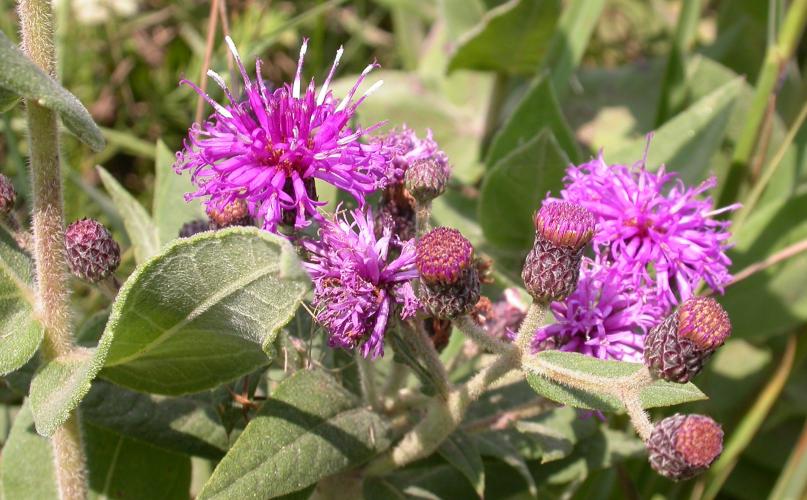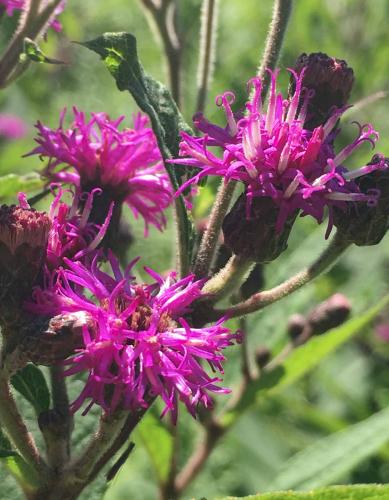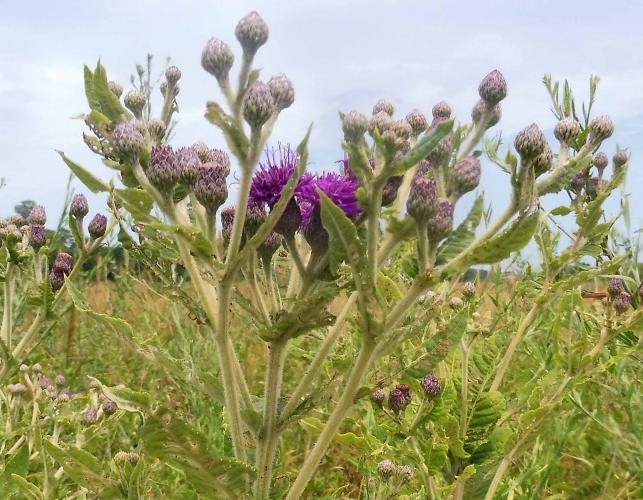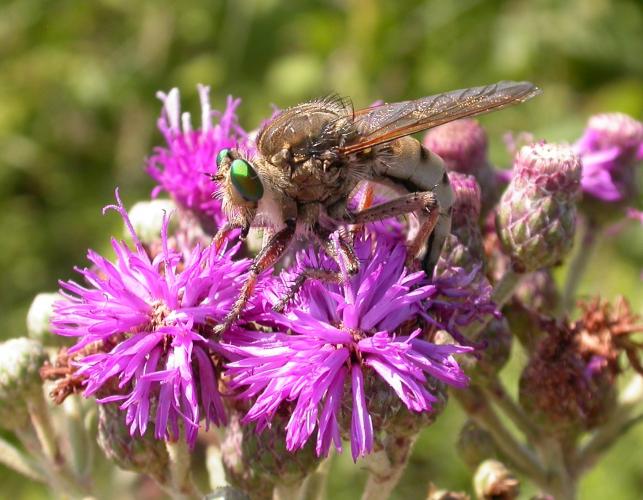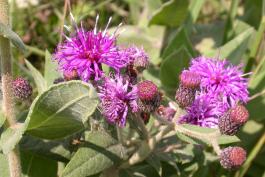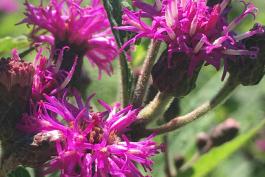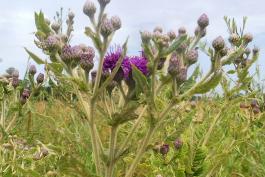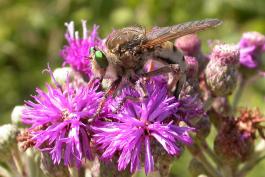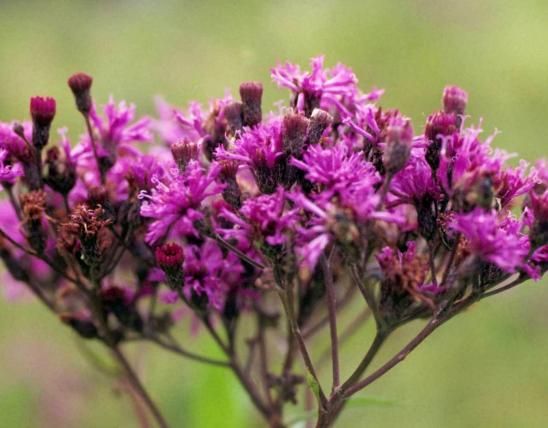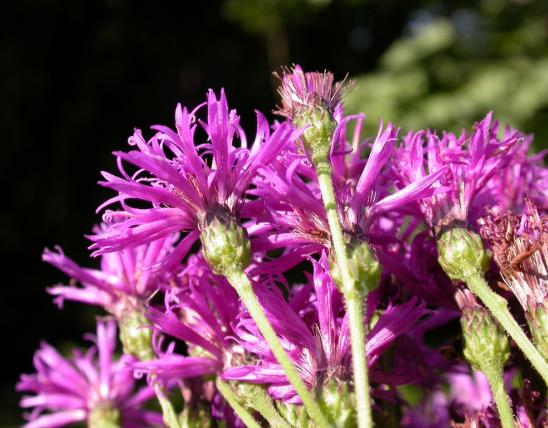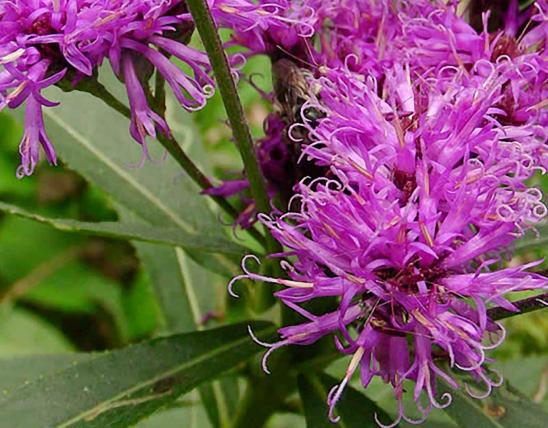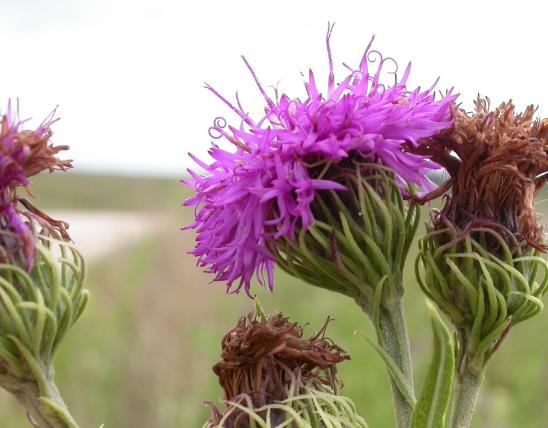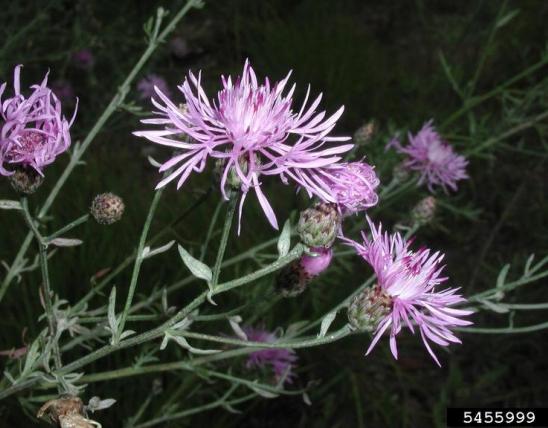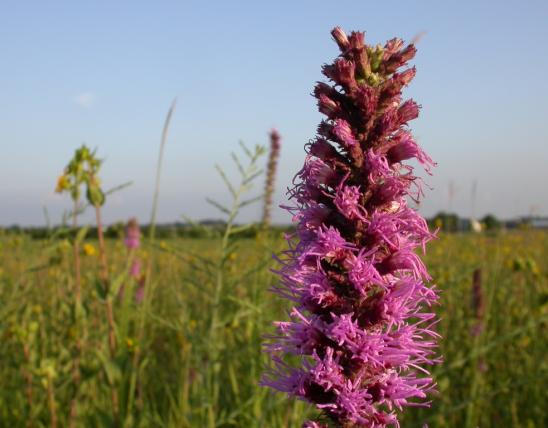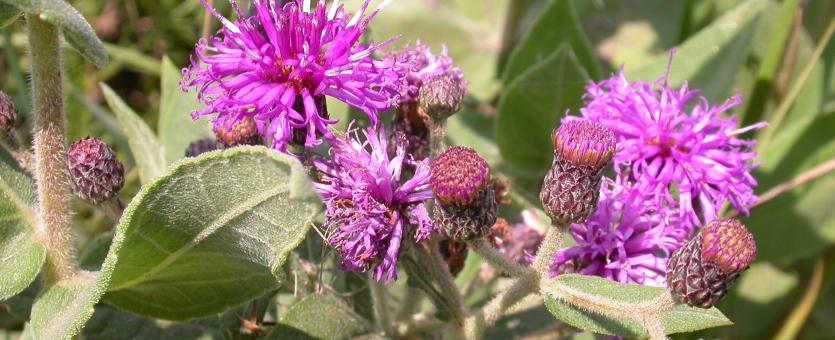
Missouri ironweed is one of Missouri’s five species of ironweeds. Compared to the others, Missouri ironweed has a relatively large number of florets per flowerhead; also, it usually has hairy stems and leaf undersides.
Like our other ironweeds, Missouri ironweed is an upright perennial that bears branching, rounded clusters of fuzzy-looking magenta or purple flowerheads in mid to late summer. The foliage is often grayish due to a covering of fine hairs on the leaves and stalks.
The stems of Missouri ironweed are hairy, with longer, spreading or often bent to tangled hairs toward the tip, sometimes minutely hairy toward the base.
Leaves: The upper surface is minutely hairy or roughened, sometimes nearly smooth; the undersurface with more or less evenly distributed, relatively long, often bent or tangled hairs; the margins range from coarsely toothed to nearly toothless.
Flowerheads have 32–60 florets per head. As with other ironweeds, the color is magenta or purple, though white-flowering forms have occurred in other states. The involucral bracts (overlapping, scalelike structures at the base of the flowerhead) are neither curly and threadlike, nor are they narrowly pointed and curling back. Instead, they are rounded or broadly angled to a bluntly pointed tip, the innermost (top) ones often abruptly tapered to a minute, sharp point, appressed (pressed snug against the flowerhead base), glabrous (smooth) or minutely hairy, glandless or with sparse, minute, impressed resin glands toward the tip, the midvein not keeled or only slightly keeled toward the tip. The margins are usually cobwebby-hairy. Blooms July–September.
Learn more about Missouri’s ironweeds on their group page.
Similar species: Tall or giant ironweed (Vernonia gigantea) is most similar, but it has fewer (13–30) florets per flowerhead, is hairless or generally less hairy, has the leaves sharply (not coarsely) toothed, and may attain a much greater height (to 6½ feet, but sometimes up to 10 feet).
Five species of ironweeds occur in Missouri. Where they grow near one another, they often interbreed and produce offspring that share traits of the parent species, making them tricky to identify. Even more confusing, these hybrid plants are usually fertile, creating more unusual combinations. If you find an ironweed whose traits don’t quite fit any single species description, you may have found a hybrid. Look around for its two parent species nearby.
Height: about 2½–6½ feet.
Scattered in the eastern half of Missouri; uncommon farther west.
Habitat and Conservation
Occurs on banks of streams, rivers, spring branches, bottomland forests, swamps, fens, margins of sinkhole ponds, bottomland to upland prairies; also pastures, ditches, old fields, fencerows, roadsides, and other open, disturbed areas.
In the Midwest, ironweeds are a familiar sight in overgrazed pastures, apparently because the plants are unpalatable to cattle. Most species in this genus produce toxic chemical compounds, but the species that occur in Missouri have not yet been implicated directly in livestock or human poisoning.
Status
Native Missouri perennial wildflower.
Human Connections
This species was named missurica after the Missouri River, which bisects our state. It’s a good way to remember its typical streamside, bottomland, and wetland habitats.
Ironweeds can be good choices for native wildflower gardening. They are highly attractive to butterflies, and they provide vibrant late-season color, especially when paired with bright yellow goldenrod, which blooms about the same time. If you want to take pictures of butterflies, park yourself next to a bunch of these blooming flowers.
Cattle avoid eating ironweed. On pastures, ironweeds are labeled “increasers,” since their numbers tend to increase over time when a pasture is heavily grazed. If you see a pasture covered with ironweed, it may have experienced heavy grazing. Most ironweeds produce toxic chemical compounds, making them distasteful to livestock, but the species that occur in Missouri have not yet been implicated directly in livestock or human poisoning.
Ecosystem Connections
The large, flat-topped clusters of intense purple flowers attract a wide array of bees, beetles, flies, butterflies, skippers, and other insects. These may feed on pollen, nectar, or both.
At least two species of digger bees, Melissodes confusiformis incondita and the eastern ironweed long-horned bee (M. denticulatus), are specialized to collect pollen primarily, or perhaps only, from ironweed species.
Many other kinds of insects eat the leaves or flowers or bore into the stems or roots, or suck the sap. These include midge, moth, and beetle larvae, aphids, stink bugs, grasshoppers, tree crickets, and katydids. Some species of moths use ironweeds as their caterpillar food plants. Leaf miners are insects whose larvae tunnel around within the leaves, eating the fleshy green tissues between upper and lower surfaces, leaving squiggly pale lines visible on the outside.
Crab spiders, orbweavers, assassin bugs, robber flies, and other predatory arthropods hunt the many insects that visit the flowers or feed on the plants.
Though a colony of ironweeds can be the home of nearly an entire food chain’s worth of insects and other small animals, mammals typically don’t eat the bitter plants.
